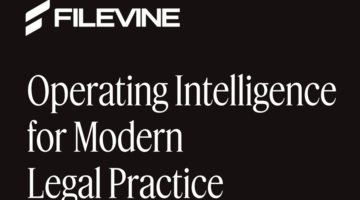
2 Milly (Screenshot via YouTube)
Late last year, the internets began popping off with news of a spate of legal claims brought against video amusement merchant Epic Games. It had so many things that were au courant at the time — Soundcloud rappers, Fortnite, viral dance moves — that the dispute seemed almost engineered in a lab to foment online hype.
But after the hype comes the motion practice and just as thunder follows lightning comes now Epic’s motion to dismiss on a number of bases, including that the case is a strategic lawsuit against public participation, or SLAPP, for which California has a specific statute.

How Filevine’s New DraftAI Cuts Out Hours Of Writing Work
Now it transforms your document creation with natural language prompts.
Epic, represented by litigator Dale Cendali, who is no stranger to claims of this nature, filed this week a motion attacking plaintiff Terrence Ferguson and his allegedly proprietary Milly Rock dance.
Epic invokes California’s anti-SLAPP statute to argue that its theft of 2 Milly’s dance was “free speech,” which is troubling. This statute was enacted to protect against lawsuits that were brought to intimidate a defendant that has criticized the plaintiff, in effect stifling the defendant’s ability to speak unencumbered. It is hard to believe that indie rapper 2 Milly is trying to “intimidate” Epic, a massive corporation raking in tens of millions of dollars from Fortnite alone, but here we are. Unfortunately, the courts have broadened the purview of what fits as “speech” within the statute to include just about anything. Like a dance in a video game.
The Ninth Circuit has questioned whether or not it should even consider an anti-SLAPP motion given that decisions on such motions do not meet the collateral order standard and its application conflicts with the standard set by Federal Rule of Civil Procedure 12. Last year, in Planned Parenthood Federation of America v. Center for Medical Progress, for example, the Ninth stated that anti-SLAPP status quo may not be long for this world, with two Judges calling for an en banc rehearing to fix the “error” that requires the Ninth to hear immediate appeals of denials of anti-SLAPP motions.
But, enough with the Supremacy Clause, we came to dance! Epic’s motion papers dig into the moves at issue but falter somewhat with unnecessary posturing. Epic overreaches, claiming incorrectly that dance moves are not copyrightable and belittling the Milly Rock dance as basic and unprotectable and simply “one of hundreds of tiny customizations” in the Fortnite game. They even cheekily use the short defined term “Dance Step” to refer to the the Milly Rock dance throughout the papers.

How Legisway Helps In-House Teams Manage All Legal Matters In One Trusted Place
Operate with AI driven insights, legal intake, unified content and modular scalability to transform efficiency and clarity.
Of course, Milly Rock is not a dance step and is instead a multi-step dance routine, albeit one that is not incredibly creative. Overstating the simplicity, and understating the creativity, of Milly Rock, a viral dance sensation that enjoys global appreciation, seems to be a poor gambit.
Because the question is in fact a relatively close one. Indeed the dance must have some creative merit based solely on Epic’s decision to incorporate the dance into its insanely popular Fortnite game. It could have just as easily used the box trot, the waltz, or any other tried-and-true cotillion-level dance. Instead, it jacked 2 Milly’s dance and freerode on its fame and appeal. To deride its substance is to deride Epic’s decision to copy.
And, really, this posturing was extraneous because the law delineates protectability and may set the standard for protection just beyond 2 Milly’s reach. As noted in our first installment on this saga, it is established that “simple routines” are not protected while protection does attach to a “related series of dance movements and patterns organized into a coherent whole.”
Epic buries the lede but eventually argues with some vigor that Milly Rock is not protectable and even if it were there is no actionable similarity between Milly Rock and the dance in the game, Swipe It. Epic avers that Milly Rock is no more than “a simple side step with an accompanying swinging arm movement and movement of the ribs that is then repeated on the other side and is performed at a quick tempo.”
And Swipe It, on the other hand, involves “pivots of the ball and heels” of the avatar’s feet as it “swipes its arms back and forth, sometimes using a straight, horizontal arc across the chest, and other times, starting below the hips and then traveling in a diagonal arc across the body, up to the shoulder[.]”
While it is hilarious to conjure up images of Epic’s high-priced attorneys gathered around a conference table hitting replay on the 2 Milly YouTube page until they had viewed his dance a sufficient amount of times to articulate the above description and dissimilarity, it means little. The court, at this stage, will be tasked looking at the alleged similarities when applying the test for infringement.
Epic argues that the above-described dances cannot be found to be substantially similar under this test. This may be true, but Epic falters in laying out the test’s particulars. It argues that the court should “filter out the unprotectable elements of plaintiff’s work” when making its comparison. But, precedent establishes that this type of filtration should be used primarily when analyzing narrative works like films or books, which often employ riffs on stock characters (e.g., the detective with a drinking habit). Looking only at the riff on the stock character while dismissing the similarities between the stock character is appropriate because that stock character is not original to the plaintiff. The impropriety of filtration in this context is driven home by Epic’s case citations, almost all of which are to cases dealing with narrative works like films and books. Savvy defense attorneys have in the past convinced certain courts to (wrongly) expand this doctrine, however, and Epic seeks to do the same here.
To filter out the steps that 2 Milly selected and arranged to create his dance would fly in the face of precedent like Horgan v. Macmillan, which explicitly stated that simple, pre-existing dance steps “may be utilized as the choreographer’s basic material in much the same way that words are the writer’s basic material.” If one were to “filter out” from a writer’s work all pre-existing words before comparing for similarity there would be no words left and no way to prove infringement of a writer’s work. The same is true here, which is why Epic is making the argument.
The closer calls will be the questions of whether the 2 Milly dance, which nobody is claiming to be particularly baroque, is sufficiently original to be protectable and whether the overall look, feel, and execution of the Swipe It dance is substantially similar in its expression. Buried in Epic’s brief is a fairly lucid argument that the answer could be “no” to both questions. If so, 2 Milly loses and may have to pay Epic’s fees before this case even gets off the ground, which would be a letdown given the fascinating issues in the mix.
Hopefully, his counsel at Pierce Bainbridge will argue forcefully in opposition to this motion. A review of the docket reveals that this firm had less than a handful of copyright cases before it filed a slew of complaints against Fortnite, and the inexperience shows in rookie mistakes like claiming “punitive damages” under the Copyright Act, which don’t exist. Epic’s counsel delights in calling these mistakes to the court’s attention as further evidence of the complaint’s frailty. But 2 Milly’s opportunity to respond is forthcoming, and issues big and small will soon be teed up for the court for oral argument next month.
 Scott Alan Burroughs, Esq. practices with Doniger / Burroughs, an art law firm based in Venice, California. He represents artists and content creators of all stripes and writes and speaks regularly on copyright issues. He can be reached at [email protected], and you can follow his law firm on Instagram: @veniceartlaw.
Scott Alan Burroughs, Esq. practices with Doniger / Burroughs, an art law firm based in Venice, California. He represents artists and content creators of all stripes and writes and speaks regularly on copyright issues. He can be reached at [email protected], and you can follow his law firm on Instagram: @veniceartlaw.